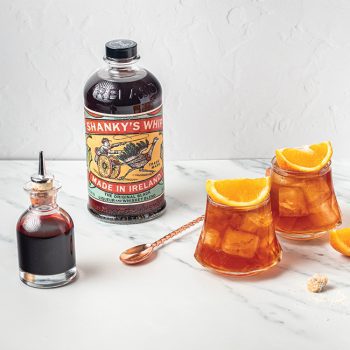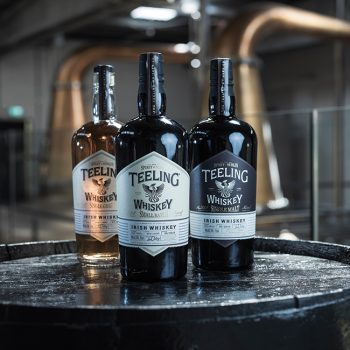How can Western spirits brands crack China?
Spirits brands stand to become successful in China, as opportunities abound for them to attract a generation of drinkers lured in by cocktail culture. But they will need to have long-term strategies in place.

*This feature was originally published in the May 2024 issue of The Spirits Business magazine.
In China, when you’re one in a million, there are 1,300 people just like you,” observed Bill Gates at the turn of the millennium. While global business leaders have fixated on the potential of Asia’s economic powerhouse (US$17.96 trillion GDP in 2022), analysts and other stakeholders are more circumspect today.
“The Chinese market has taken some hard knocks in recent times – the nation came out of lockdown far later than other headline economies,” observes Spiros Malandrakis, head of research – alcoholic drinks, Euromonitor International. “Therefore the recovery that many predicted would sweep the board in 2022 simply did not materialise.” According to IWSR Drinks Market Analysis, total spirits volumes fell by 17% between 2021 and 2022, and the consumption of “flavoured and national spirits” plummeted by 32% and 17% respectively.
“We live in a capricious world, and China is no exception,” says Malandrakis. “The country is facing significant demographic issues, while youth unemployment is growing and the economy is flatlining.”
This downturn has been keenly felt by export-orientated multinationals such as Pernod Ricard. Releasing its third-quarter sales figures in April, the company referenced a “challenging macroeconomic environment in China”, with a decline of 12% in net sales, indicative of softening consumer interest. The owner of the Scotch Malt Whisky Society, Artisanal Spirits Company (ASC), meanwhile, revealed that the Chinese market had “performed below expectations” in its preliminary sales results for the year to 31 December 2023; last year China’s revenue plunged by 30%.
However, ASC’s 2023 Annual Report added: “We expect the recovery in China will be at a steady pace over the next two to three years.” But is that just wishful thinking, or a sound prediction?
Quentin Meurisse, vice-president of business acceleration and planning for The Absolut Company, is bullish about the potential for expanding distribution, notwithstanding recent declines. He says: “We’re early movers in categories that have a limited footprint in China and, off this limited base, we’re seeing rapid growth.
“Absolut is our most developed brand in China, it’s contributing most of our portfolio growth, and we see plenty of runway to keep growing. Some of our other brands show higher growth percentages, but off smaller bases, so we’re seeing emerging signs of the potential to replicate the extraordinary success of Absolut in more white-spirits opportunity spaces.”
Dynamic market
Meurisse describes China as a “very dynamic market with sophisticated, well-informed consumers”.
Like in all developing markets, he anticipates a continued evolution in taste preferences, purchase patterns, and wider trends. “[Imported] brands that manage to deliver what consumers desire in terms of product quality and brand experience will have exciting growth opportunities in the coming years,” he predicts.
Nonetheless, China, like many Asian societies, provides fierce competition in the shape of domestically produced alcohol; baijiu still accounts for more than 95% of spirit consumption in the nation. Indeed, it is an ubiquitous tipple at banquets, and encompasses all price points, including the very top end, where volumes dwarf those of imported prestige spirits.
“However, if we exclude baijiu from this discussion, almost the entire spirits market in China is made up of imported brands at premium-and-above price brackets,” explains Shirley Zhu, research director – greater China, IWSR Drinks Market Analysis. “At standard-and-below price segments (excluding baijiu), imported brands make up about 95% of the spirits market in China.”
But Zhu raises an important caveat: ongoing premiumisation in the baijiu category is a rising threat to imported labels. “The lowest price segment of baijiu is now declining rapidly as tougher government regulation and increased consumer education push producers towards higher-quality brands,” she reports.
“As a result, manufacturers have had to upgrade their products, and some ceased production of low-end brands.”
 Cotswolds Distillery CEO Jeremy Parsons, however, isn’t unduly concerned. The firm has recently appointed AI Beverage in the domestic market, securing new listings agreed with China Duty Free. “Granted, there have been economic headwinds that are affecting consumption, but we believe premiumisation trends will continue as Chinese consumers show a preference for higher-quality spirits,” he says.
Cotswolds Distillery CEO Jeremy Parsons, however, isn’t unduly concerned. The firm has recently appointed AI Beverage in the domestic market, securing new listings agreed with China Duty Free. “Granted, there have been economic headwinds that are affecting consumption, but we believe premiumisation trends will continue as Chinese consumers show a preference for higher-quality spirits,” he says.
Much expectation revolves around the open-minded dynamism of millennials and Gen Z, who are “more willing to try new and innovative spirits, including craft and flavoured spirits”, according to Parsons.
 “I think post-Covid, there has been a tremendous resurgence in the on-premise, with cocktail culture slowly becoming a thing,” agrees Elwyn Gladstone, founder of Irish whiskey liqueur Shanky’s Whip. “Younger Chinese consumers are getting more interested in ‘Western’ spirits – learning the provenance of them, and different ways to use them.”
“I think post-Covid, there has been a tremendous resurgence in the on-premise, with cocktail culture slowly becoming a thing,” agrees Elwyn Gladstone, founder of Irish whiskey liqueur Shanky’s Whip. “Younger Chinese consumers are getting more interested in ‘Western’ spirits – learning the provenance of them, and different ways to use them.”
However, Stuart Campbell, head of operations at Lighthouse Brands, offers a more sanguine appraisal. “The overall economic situation with regard to spirits sales in China is in decline,” he reports. “That said, there is an increase in popularity for low-alcohol RTD [ready-to-drink] products. In China the Choya Extra Years Umeshu is really popular.”
Yet it is premium whisky that has really stolen a march with Chinese sybarites in recent times, muscling in on Cognac’s territory. “With only whisky showing top-line category growth in 2022, in many ways, 2023 is looking like a transitional year for China’s beverage alcohol market,” observes the IWSR’s Zhu. In contrast, vodka, rum, gin and agave all posted volume declines in 2022; agave experienced a contraction of 7% in 2022, while other categories saw a double-digit reduction in sales.
Rise in value
According to Emily Roads, head of trade – Asia Pacific at the Scotch Whisky Association, “China is our fifth-largest market by value, with exports growing more than 250% in the past decade. The rise in value of single malt exports to China is a clear indication of the increasing premiumisation of the market and growing appreciation among Chinese consumers for Scotch whisky.”
 Martin Lynch, Asia Pacific commercial manager at Teeling Whiskey, is no less optimistic. He says: “The discerning palates of Chinese whiskey consumers have responded well to our innovative approach, award wins, and accessible flavour profiles.
Martin Lynch, Asia Pacific commercial manager at Teeling Whiskey, is no less optimistic. He says: “The discerning palates of Chinese whiskey consumers have responded well to our innovative approach, award wins, and accessible flavour profiles.
In recent years this has translated to very strong demand for our flagship Small Batch Whiskey as well as our super-premium single malt offerings.
“Despite some current macroeconomic-driven headwinds dampening consumer sentiment and impacting our sales momentum, we believe the market continues to present a strong opportunity for Teeling Whiskey over the medium to long term.”
Fraud and regulatory oversight, however, remain key concerns for brands operating in China; alcohol counterfeiting is a lucrative – and thriving – part of the nation’s black economy. “With this growing demand and interest from consumers, it is important that government and industry on both sides work together to ensure a protected and responsible market in China,” says Roads. “With the right regulatory environment, including the necessary legal protections, the Scotch whisky industry is well placed for continued growth in the future.”
Too much bureaucracy
At the same time, other brands have withdrawn from the market because of too much red tape. “Tito’s is no longer doing business in China because of changing – and quite onerous – registration requirements there,” explains John McDonnell, managing director, international, at Tito’s Handmade Vodka. “Tito’s isn’t willing to share the unreasonable level of information that it has been requested to provide.”
China, like all nations, offers its fair share of obstacles and contractions: a population of 1.4 billion people with a relatively small audience in the market for imported premium brands; an infamous and far-reaching bureaucracy that faces an onslaught of fraud and counterfeiting. “Success is all about finding a good importer who takes a long-term approach and tries to be innovative in the way they go to market and introduce the brand,” counsels Gladstone.
Yet Euromonitor’s Malandrakis remains ambivalent about Asia’s largest economy and the potential for further growth. “In many ways, China is a reflection of trends taking place across the world. Yes, we’re talking about a recovery narrative, however, it is a narrative diluted by the numerous uncertainties on the horizon,” he says.
“If Trump wins the American election in 2024, for example, then the US and China’s trading relationship is likely to become more defensive and protectionist, while consumer nationalism is on the rise among younger drinkers.
“Indeed, nationalist-leaning pride is a growing phenomenon among this cohort, who are increasingly open to premium/super-premium domestic brands, in addition to imported labels.”

As further evidence, several firms, including Diageo and Angus Dundee Distillers, have invested heavily in domestic collaborations and joint ventures. In December 2023 the latter announced it was building a malt whisky distillery and visitor experience in China, situated on a 20-acre site near Thousand Island Lake in Chun’an, Zhejiang province. Meanwhile, the Chinese government launched an anti-dumping investigation in January this year, taking aim at EU-origin imports of Cognac and brandy. According to Reuters, China imported US$1.57bn worth of spirits distilled from grape wine in November 2023; the popularity of Martell is a key part of Pernod Ricard’s relative success in the country.
Marketing arsenal
Multinational partnerships aren’t the only weapons in the marketing arsenal of corporate investors and smaller businesses alike. Innovation, occasion stratification (particularly the rise of cocktails), and image premiumisation are all potent forces in the campaign to lure Chinese consumers away from the growing volume of pricey baijiu.
Despite the ongoing macroeconomic uncertainty, evidence from many sources indicates people are willing to trade up and across to Western brands, if given a strong reason to do so. The ball, ultimately, is in the industry’s court.
| US distilled spirits exports, in millions USD | |||
| Year | China | Hong Kong | China & Hong Kong |
| 2023 | $21.5 | $4.6 | $26.1 |
| 2022 | $23.5 | $2.6 | $26.1 |
| 2021 | $22.6 | $2.8 | $25.4 |
| 2020 | $16.7 | $2.9 | $19.6 |
| 2019 | $18.0 | $6.9 | $24.8 |
| 2018 | $18.1 | $6.9 | $26.5 |
Source: United States International Trade Commission
Related news
How the spirits market in China is recalibrating
